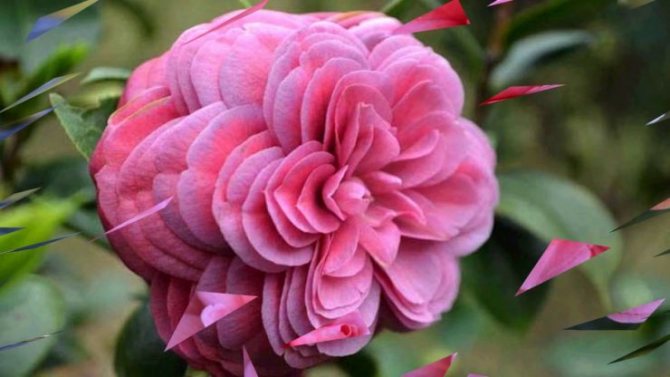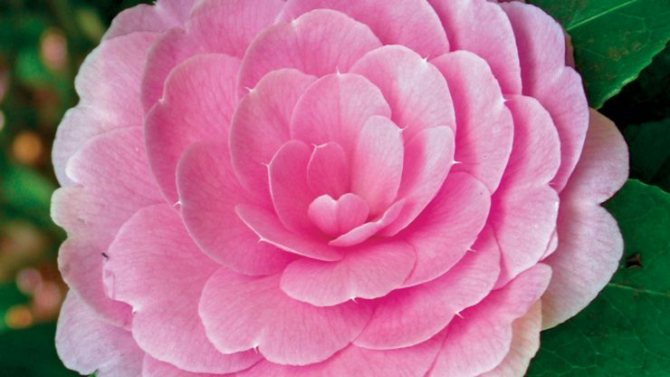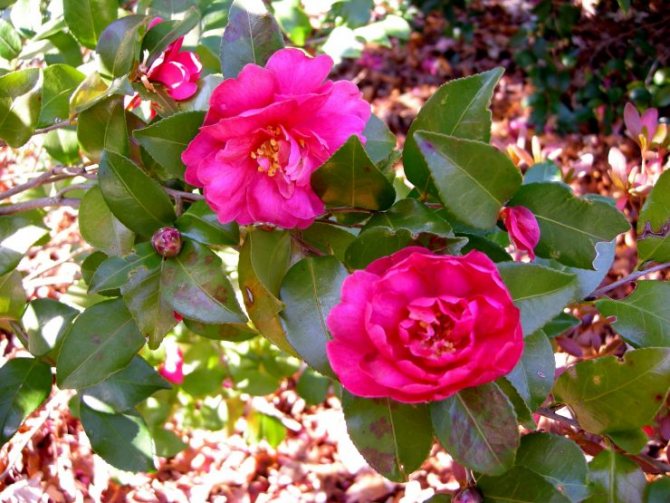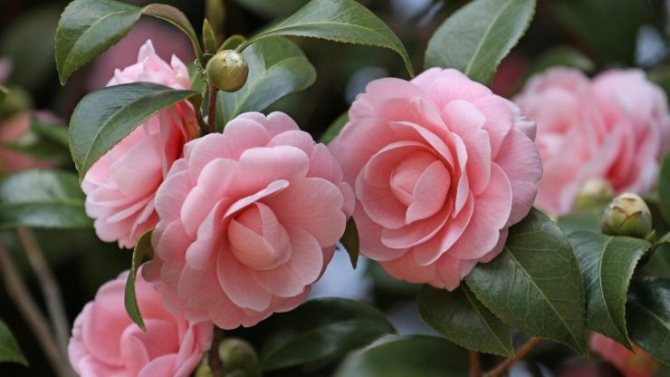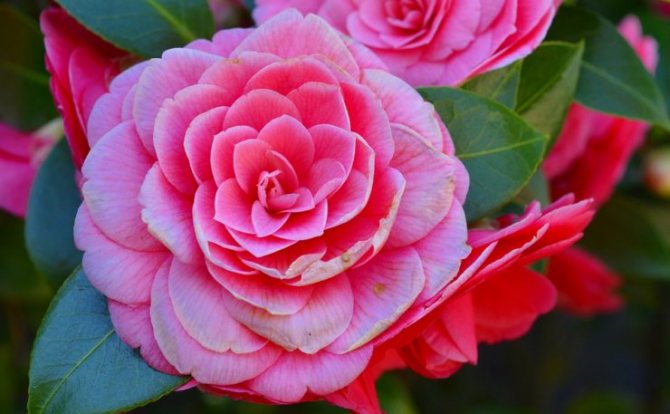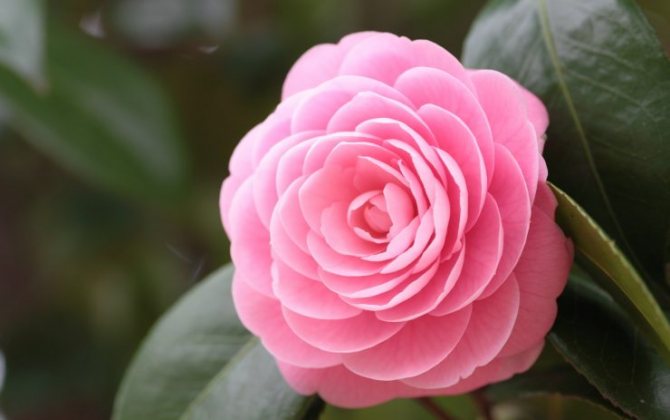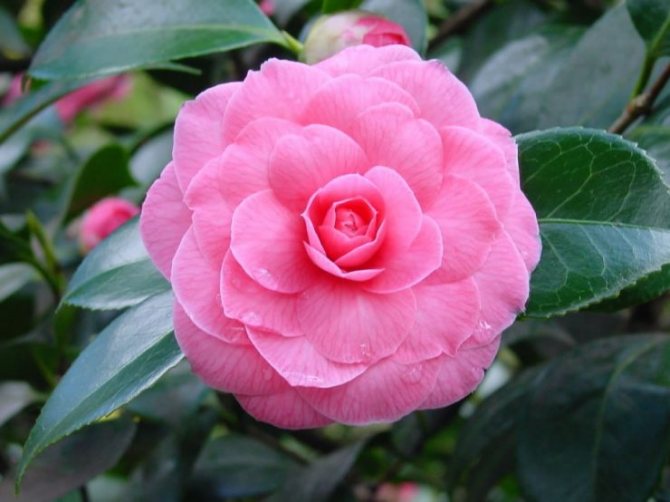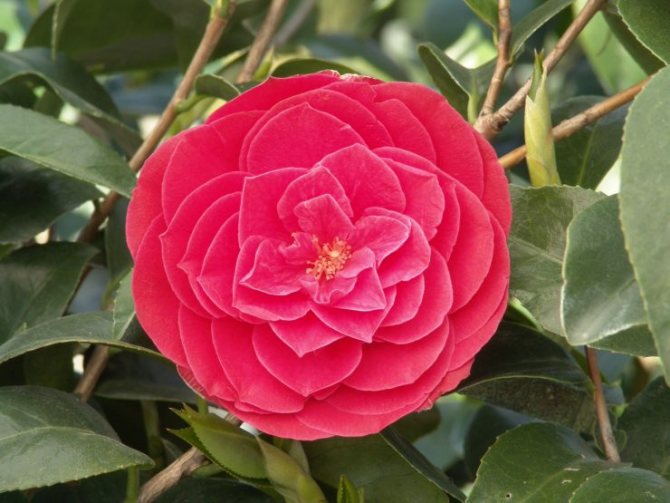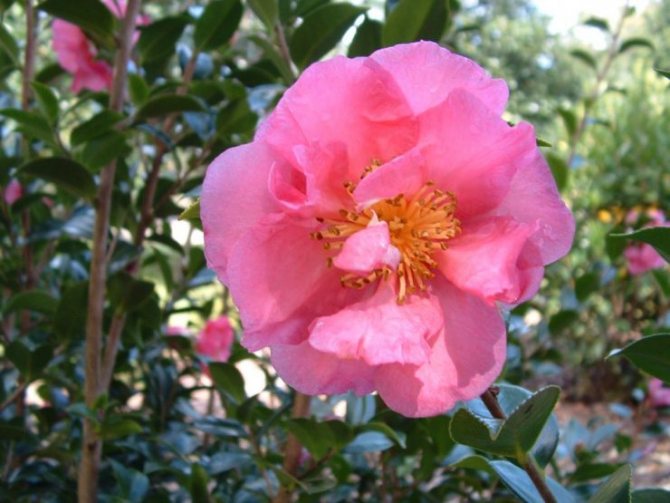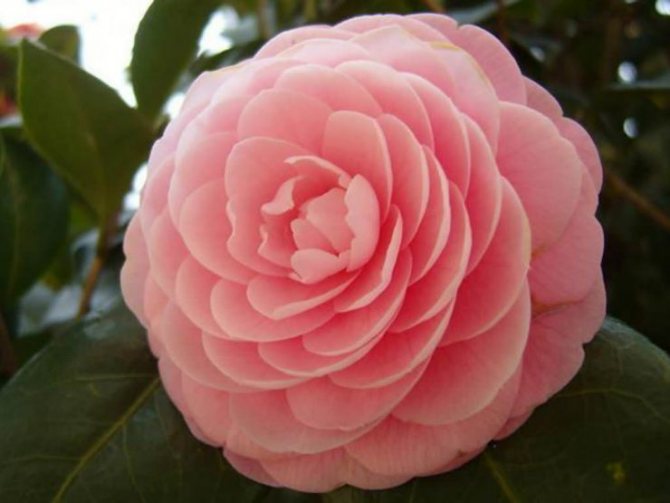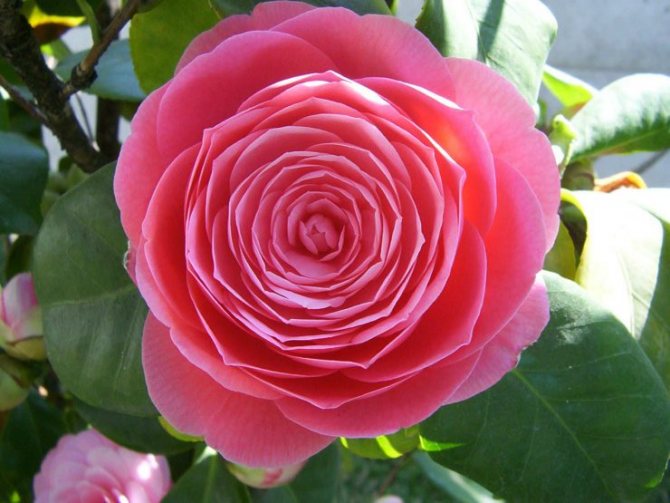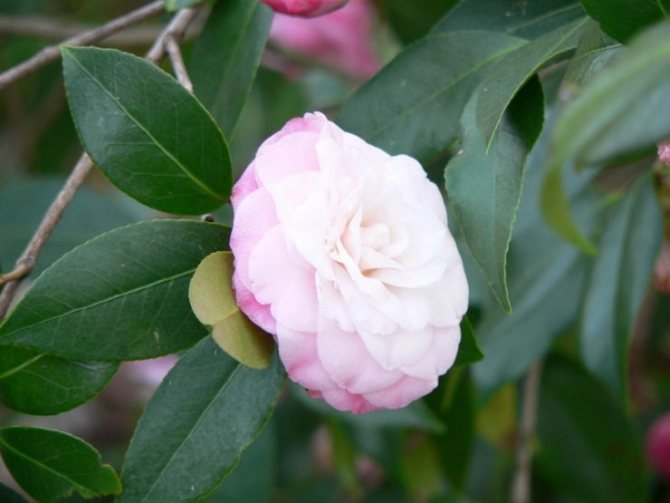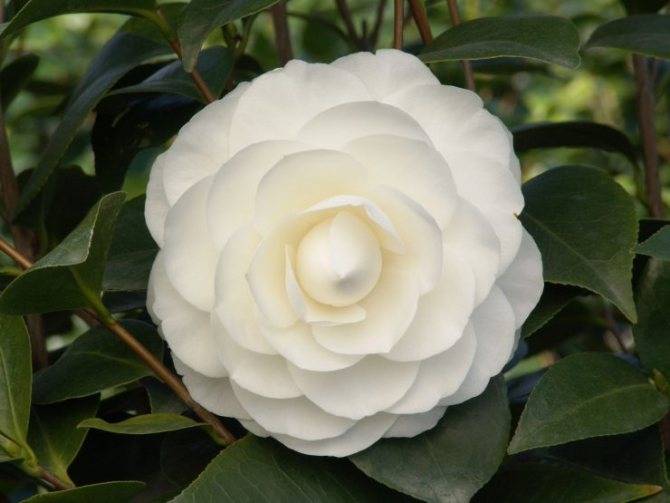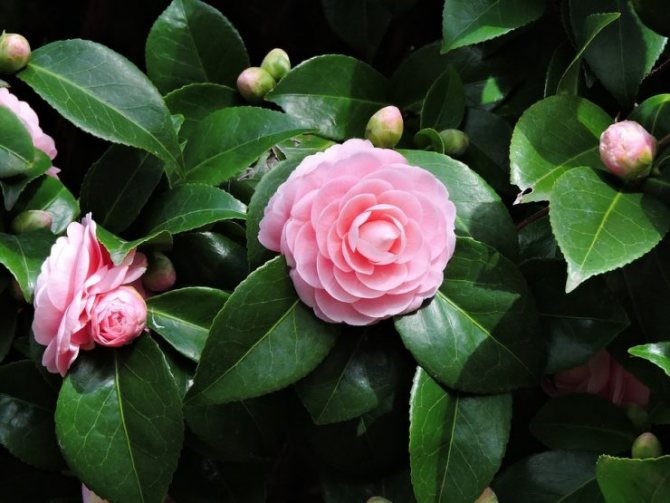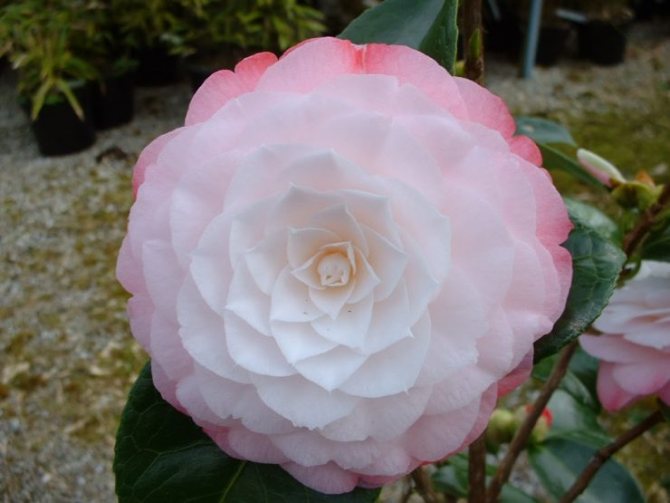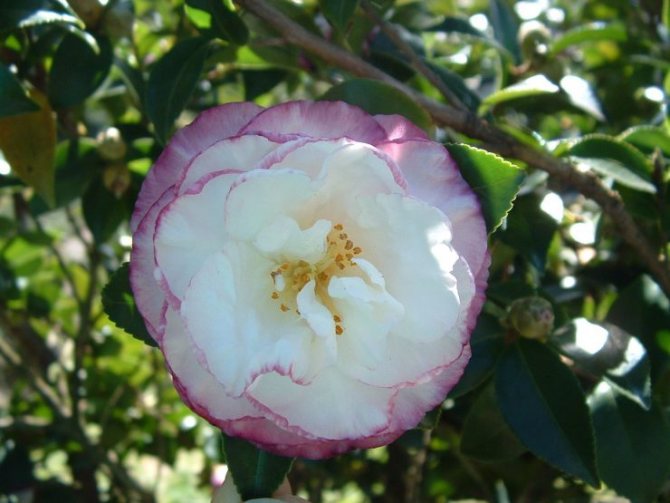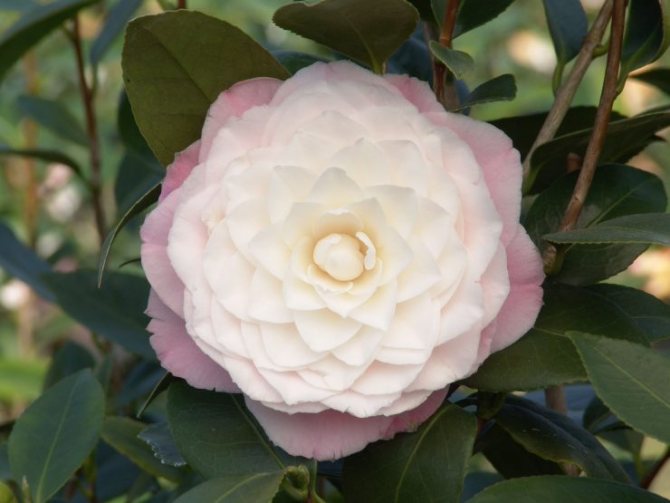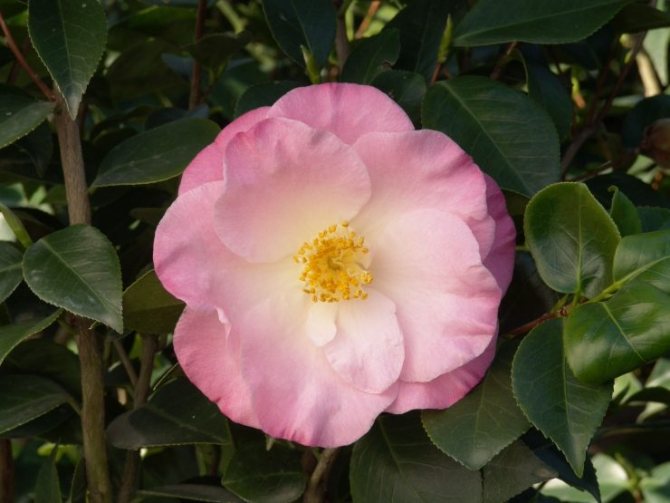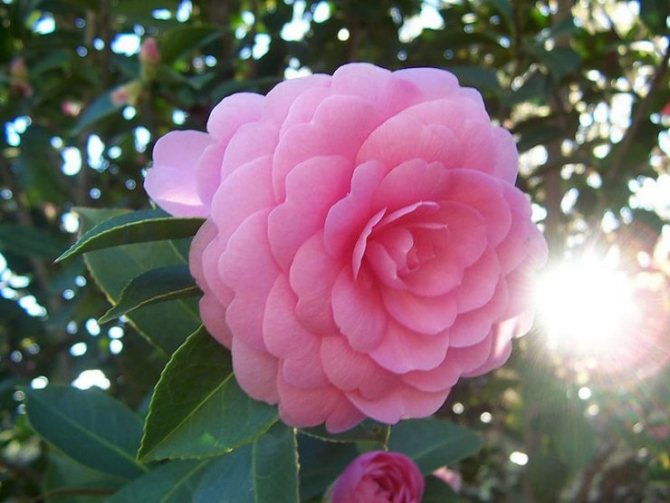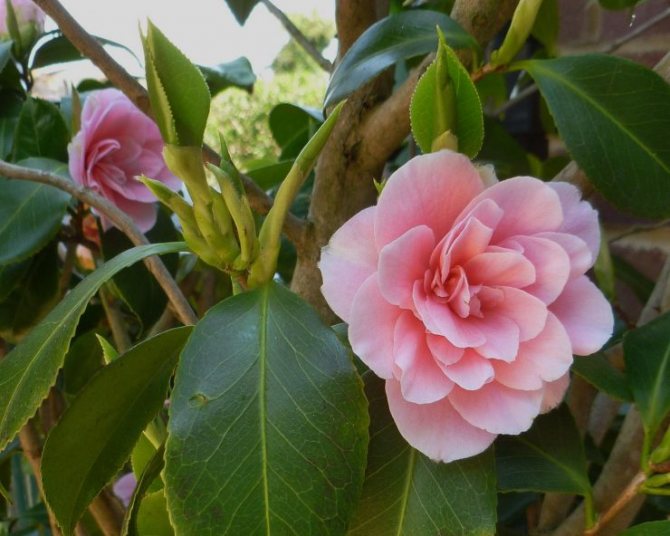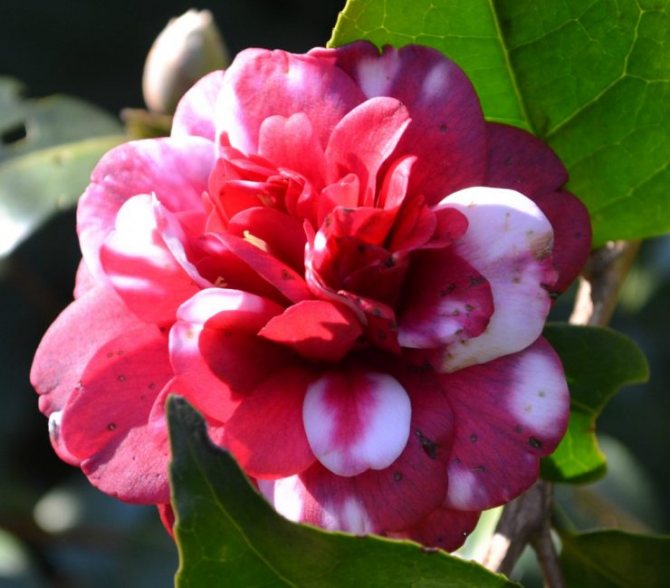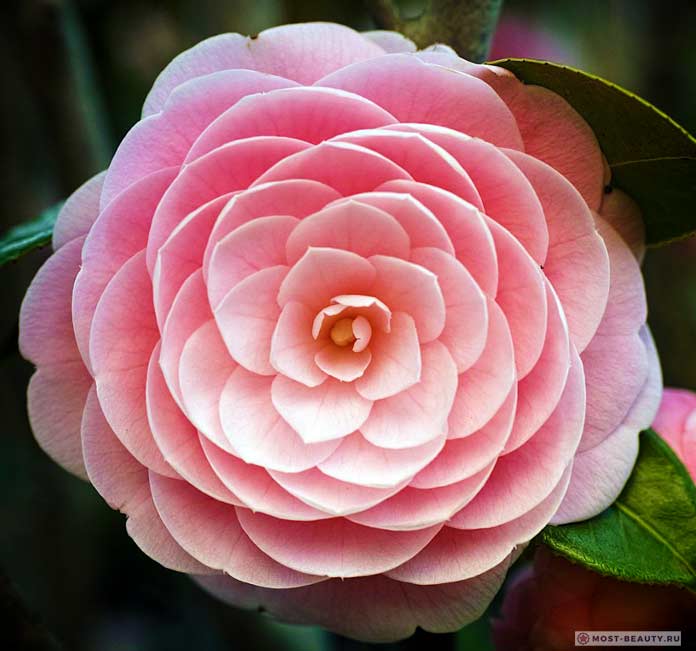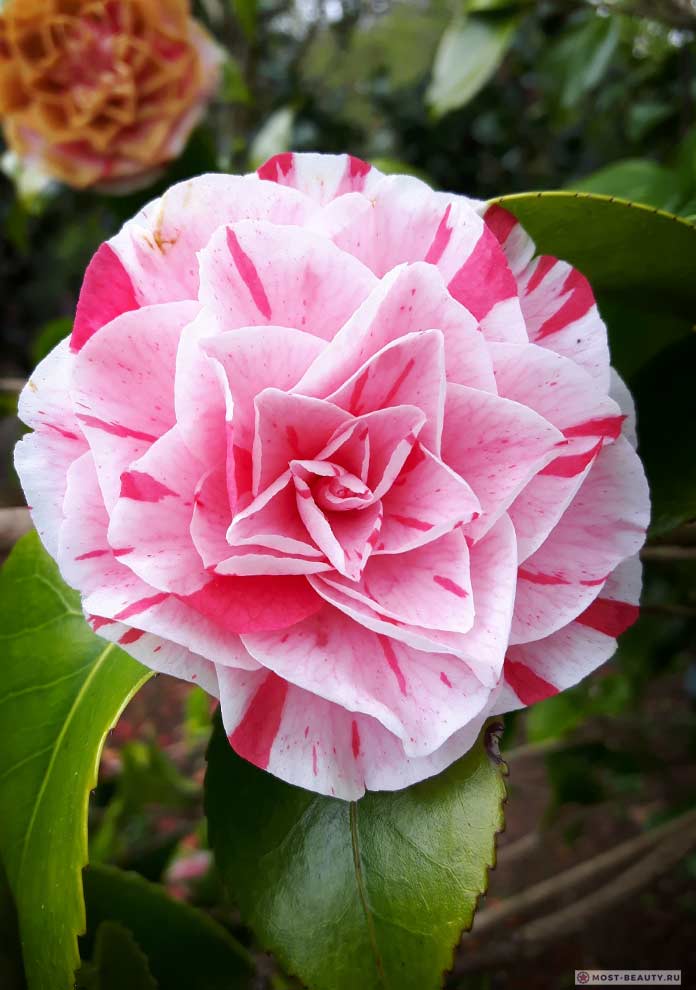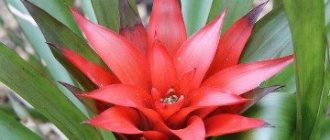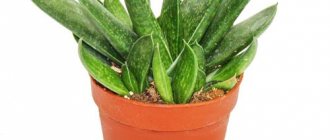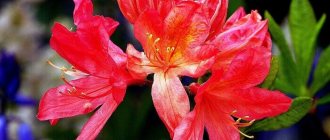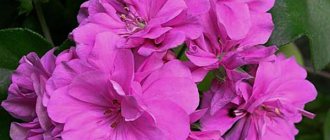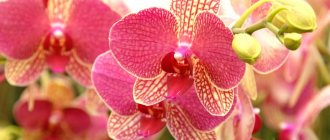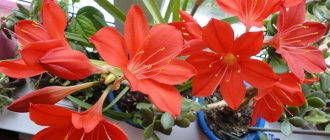A beautiful but soulless flower, the camellia has earned a reputation for being touchy with a cold heart for a reason. During flowering, it is perfect, but has no fragrance, and its petals seem to be made of wax. Like a real sleeping beauty, she dissolves the buds, only falling into a state of rest, often demonstrates character and not everyone allows herself to be tamed.
But, as in life, an unapproachable appearance can be deceiving. Having understood the physiological characteristics of the plant, having created the right conditions, it is not difficult to grow camellia. And we will prove it by revealing the secrets of a flower, capricious at first glance.

Japanese camellia
This is one of the most common types. The color of the buds can be white, pink and red. The flowering period is from November to May, and the duration can be up to one month.
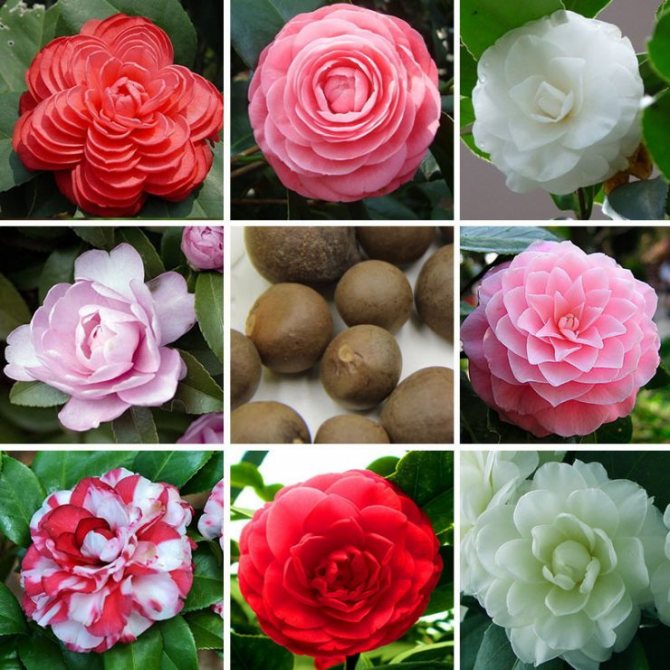

In the wild, the tree can reach 11 meters in height, but houseplants grow no more than a meter.
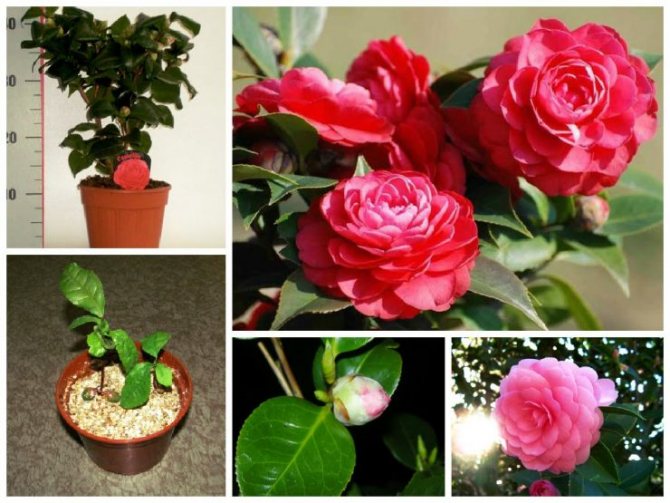

A subtropical plant that doesn't like the tropics
Warm ocean currents and humid monsoons define Japan's climate. On most islands, it is warm and humid, turning southward into the subtropics and tropics. In winter, the temperature rarely drops below zero, snow is a curiosity here.
The flora of Japan is represented by a wide variety of evergreen trees and shrubs. The vast forests are made up of cypresses and magnolias, tree ferns and jagged oaks, and under their canopy there are thickets of rhododendrons and beautiful camellias, which the Japanese adore and grow in special natural gardens, as can be seen in the photo below.
In addition to Japan, the plant is widespread in the subtropical zone of China, Korea, and Vietnam. There are mountain types of shrubs that are more enduring and feel great in the open sun.
Camellia came to Europe about 200 years ago. It was brought by the Czech botanist Georg Kamel, who is engaged in missionary and medical activities in the Philippines. The Japanese rose was named in his honor. Unfortunately, he did not find out about this, since the indicated event took place 30 years after his death.
What does it look like?
Camellia is a member of the Tea family. Yes, yes, one of the species of this plant is called the tea bush, and its leaves serve as raw materials for the preparation of one of the most popular drinks.
In nature, it is an evergreen shrub or a small tree 10–15 m high. Leaves on short petioles, alternate, elliptical, serrate along the edge, like a rose. They are quite dense and so glossy that they reflect the sun's rays, letting in "bunnies". Due to the leathery dark green foliage, the bush looks very elegant even without flowers.
Flowers are single, large, 12-15 cm in diameter. In nature, they are simple or semi-double, mostly red or white. The cultivated assortment is represented by a wide variety of terry shapes and shades. Among them are surprisingly graceful specimens, such as the Middlebury pink camellia, whose petals resemble neatly laid tiles.
Under natural conditions, camellia blooms from January to March, but in some modern hybrids this period extends to six months - from November to May.
Another unusual feature of the Japanese rose is the gradual wilting of the flower, which falls off entirely, while maintaining a bright color.The bush always looks neat - no faded, dried flowers with crumbling petals.
Loves, dislikes - natural preferences of camellia
Camellia is a plant in its natural environment intended for open ground, it is grown indoors because of our cold climate. And since the plant is subtropical, then they try to create greenhouse conditions for it. This is precisely the main mistake. To better understand the preferences of a flower, consider what environment it is used to, and how this affected its physiology.
- The plant loves warm weather, but not hot, humid, without sharp seasonal fluctuations. In its natural environment, an evergreen shrub overwinters in the temperature range of 7–10⁰ plus, if there is a cold snap, it is short-lived and not strong.
In our latitudes, camellia painlessly tolerates summer, but with winter - problems. It is unacceptable on the street (the minimum temperature that it can withstand is 10 frost), in a room at + 20-25⁰C it is too hot.
- In nature, the shrub grows under the forest canopy, in the lacy shade of taller neighbors. Prefers diffused light, long daylight hours. In the room, the window sills of the eastern and northern windows are suitable for the flower.
- The monsoon climate of the plant's homeland provides high humidity. Like orchids, garden camellia loves spraying, and also so that there are sources of moisture evaporation nearby.
- Growth in the undergrowth with a large number of conifers determines the composition of the soil. It is light, airy, with an acidic reaction (pH 4.5–5.5). A pillow made of coniferous deciduous litter gets wet well, but does not retain water.
To summarize, the main preferences of a houseplant are a lot of diffused light, low positive temperatures during flowering, acidic loose soil and good air humidity.
Accordingly, the open sun, the content in a warm room in winter, an unsuitable planting substrate, and a lack of moisture oppress the culture.
Features of the annual development cycle
We love flowers after hours. We "deceive" the bulbous plants by forcing them to bloom in winter, but there is a whole group of plants for which this is a natural stage of the annual cycle. Our heroine also belongs to them.
- The growing period of garden camellia begins with a general awakening of nature - in April-May. At this time, it builds up the vegetative mass, strengthens the root system. Shoot growth continues until mid-summer.
- From about August, the laying of flower buds begins.
- In the middle of autumn, buds appear, which will open only with the onset of a suitable temperature regime.
- At the beginning of winter, the plant blooms, but at the same time all other organs (shoots, leaves, roots) stop growing.
In fact, camellia is a flower that blooms during sleep, which complicates caring for it at home.
Chinese camellia
Long tea is made from the leaves of such a plant, and the flowers are used as natural flavors.
This camellia is not grown at home. It is more suitable for industry.


Popular varieties
There are such types of camellias as olive, Chinese, mountain. But the best varieties and hybrids that we know are obtained from Japanese camellia.
Debbie
Frost-resistant variety. This shrub grows pretty quickly and looks great. Against the background of dark green shiny leaves bloom waxy bright crimson-pink multi-petal flowers. The plant is characterized by abundant and long flowering.
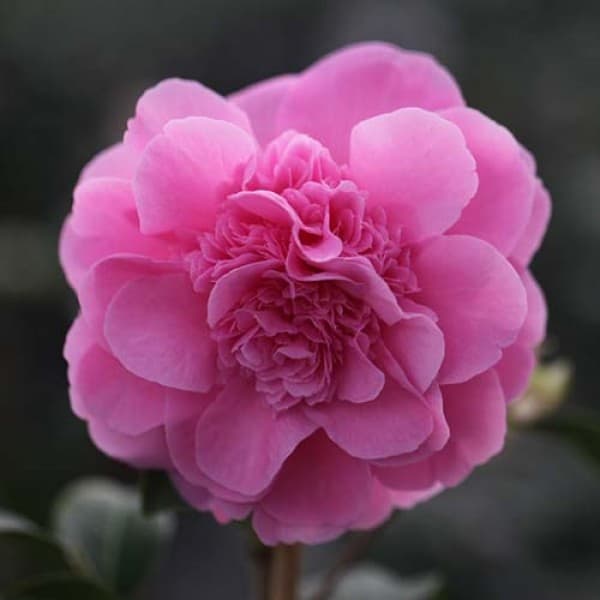

Donation
It differs from the previous variety in larger flowers, and having a double flower structure. Compared to other species and varieties, this camellia is quite unpretentious, it grows a little slower than the rest. Recommended for growing novice gardeners.
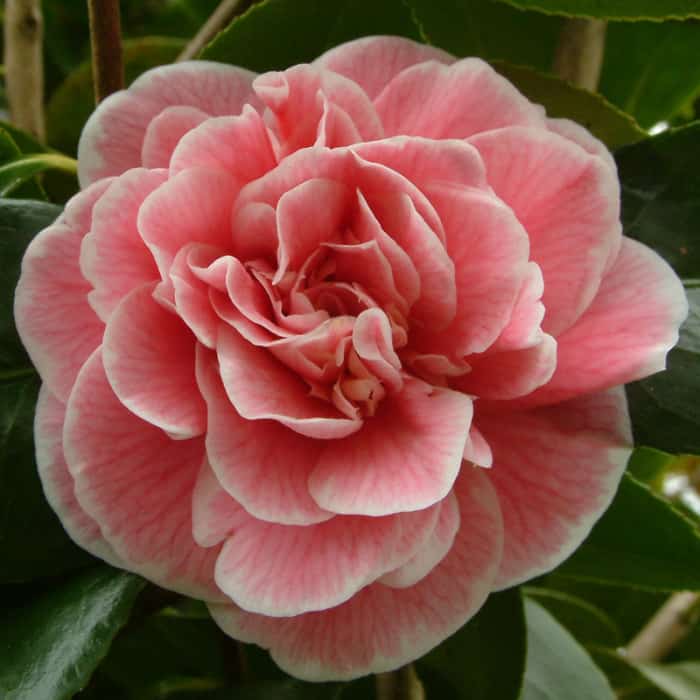

Freedom bell
The pointed, regular-shaped petals of this variety of camellia seem to have been carved by a sculptor, and the scarlet color simply does not allow such beauty to pass by. The bush itself has straight branches and dense, shiny, large-sized foliage of a rich green hue.
Hagoromo
This camellia grows slowly, the shape of the bush is lush and dense, and the flowers, on the contrary, are graceful and have a pure shade of white with a yellowish core, the petals seem to be porcelain.
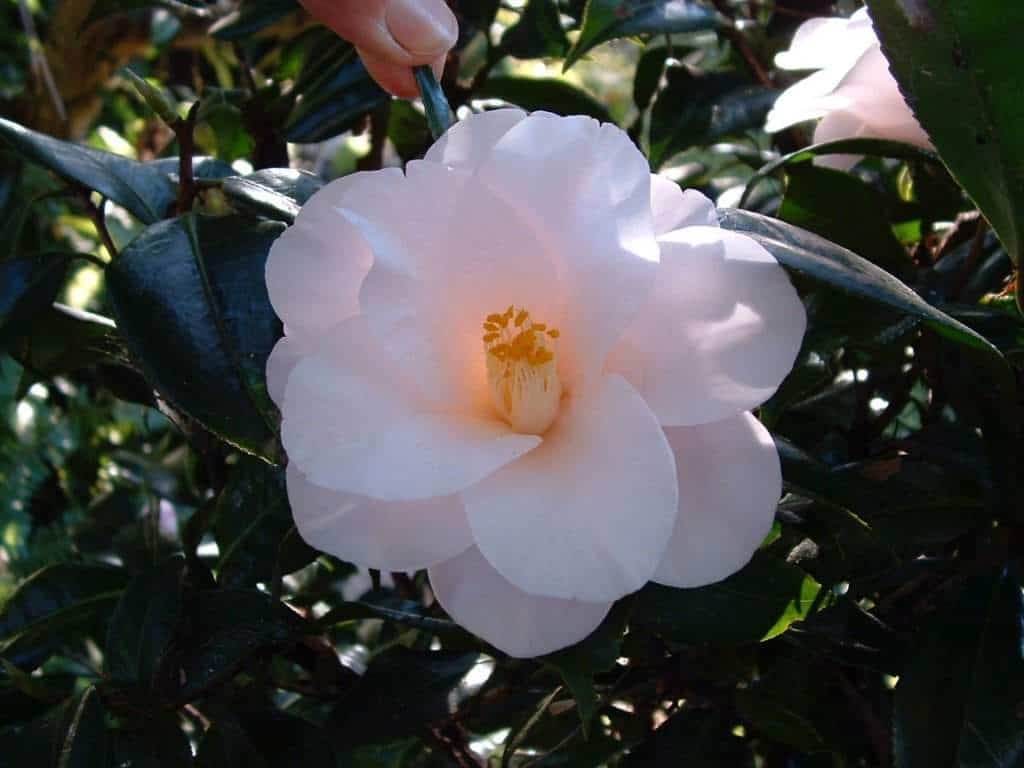

General Colletti
This variety is distinguished by simply extraordinary flowers - red and white petals will be a bright accent and decoration of any corner of the garden or flower garden.
All these varieties remain green throughout the winter, and the flowering of each variety, although it differs in the structure of the petals and shades, but, no doubt, confirms another name for the camellia - Empress.
Mountain camellia
This flower grows in the highlands of the Japanese islands of Kushu and Okinawa. She loves coolness, and not too scorching sun, blooms from November to February.
To date, about a hundred variations of mountain camellia have been bred. Among them are both home and garden options.
Preparing for landing
Before planting a camellia in open ground, you need to carefully prepare and think over everything to the smallest detail. Let's consider several main stages.
Selection of variety and planting material
- The best time to purchase seedlings and plant them in open ground is from late April to mid-July. In the autumn, camellia can only be planted in the south.
- Saplings should be four years old and have lignified bark on the shoots.
- It is recommended to purchase planting material in special nurseries and stores.
- Depending on the region (southern or more northern), choose the appropriate variety.
- Before deciding to buy, you should take a good look at the bush: the soil in the container must be clean and moist, and damage, dry or diseased shoots and leaves are unacceptable on the seedling.
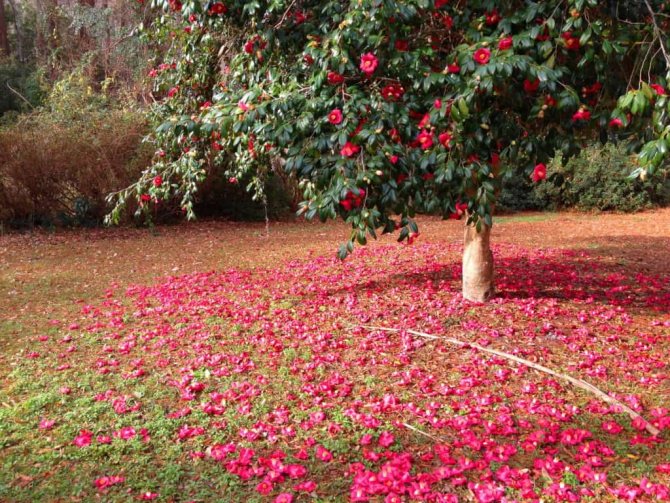

Choosing a landing site
From where in your garden or flower garden you decide to settle this shrub, its further growth and flowering depends.
- It would be best to have camellias on the western or eastern side of the site, where there is not only the sun, but also diffused light, and sometimes partial shade. On the northern side, the sun is not enough to start the budding process, and too strong scorching sun rays can be aggressive.
- The intended place should be free from cold winds and drafts.
- Shrubs on a small hill or hill will be most comfortable, especially if the groundwater in your area flows close to the soil surface. And stagnant water and dampness are contraindicated for camellia and can cause rotting of the root system.
- A small partial shade from large garden trees or bushes will only benefit camellias.
Soil composition
The shrub likes a neutral or acidic soil composition. Planting mix can be purchased at a specialty store or you can make it yourself. Usually, they add to the coniferous soil: for the drainage layer, coarse-grained river sand (sometimes the bark of coniferous trees is added for acidification), peat, perlite and vermiculite.
Organic material and a small amount of gravel added to the drainage layer will provide better ventilation of the root system and an even supply of oxygen.
Mesh camellia
This is the largest species, reaching a maximum of 20 meters in height.
The flowers of such a camellia are the largest (up to 20 centimeters in diameter). And their peculiarity is that they contain several shades of different colors.


Transfer


Camellia is transplanted not in February-March, like other indoor flowers, but in late autumn or winter. She begins a dormant period that coincides with flowering. Therefore, you can transplant a flowering plant, observing accuracy.Young plants need replanting every year. Large bushes can be transplanted using the transshipment method once every two to three years, when the roots fill the entire volume of the pot.
In preparation for transplanting (planting), it is necessary to prepare a wide pot, on the bottom of which a layer of drainage is poured. The land can be bought ready for azaleas, camellias. Since different manufacturers allow deviations in the composition, when buying a ready-made earthen mixture, you should pay attention to the presence of the following components in the soil:
- peat;
- sand;
- leafy land;
- vermiculite.
You can prepare the mixture yourself by mixing peat, sand, leafy and coniferous soil. All ingredients are taken in equal parts, and the sand is half as much. The soil should be loose so as not to allow stagnant water. The acidity of the soil should be in the range of 4.0-5.5 units. To increase its permeability, it is recommended to add ground coniferous bark. Pieces of it are usually sold for planting orchids.
It may be interesting: Types and varieties of indoor (home) roses
When transplanting a flower, you should pay special attention to the root collar, which should not be covered with soil, but should be at ground level. When transferring an adult plant, a fresh mixture is added to a larger pot. If it is necessary to increase the acidity of the soil, mulch it from above with sawdust or small pieces of bark.
Rules for caring for camellia at home
This is a rather picky plant, and requires special care for itself.
Description and features
According to botanical taxonomy, this exotic plant with an evergreen crown and ideal for indoor cultivation belongs to the Tea family. They cultivate both tree and shrub forms of camellia, which are bred in order to obtain exquisite flowers or decorative deciduous plants.
Elliptical leaves, which are usually blunt or pointed at the ends, have a leathery glossy surface. Usually they grow singly.
Camellia flowers are characterized by a large number of stamens, around which white, pink or red petals are located, accreted at the base. Each flower blooms for at least a month. In total, camellia is able to delight with its flowers, similar to lush roses, for about three months, which distinguishes it favorably from many ornamental plants. The fruit is a dry capsule consisting of 5 compartments with 8 seeds.
A distinctive feature of the camellia, which makes it attractive to flower growers, is two growth periods. Thanks to this feature, the plant has the ability to develop faster. In winter, closer to spring, the houseplant actively grows shoots and foliage, and in summer, when camellia blooms, after the second phase of growth, the formation of vegetative buds begins.
With all their appearance, beautiful flowers are encouraged to smell them. Unfortunately, they do not emit a wonderful aroma - the smell is practically absent.
Suitable placement and light
Camellia is best placed on windows that face east and west. During the flowering period, it is forbidden to rearrange the flower, and even move the pot. Limit it from direct sunlight and drafts.
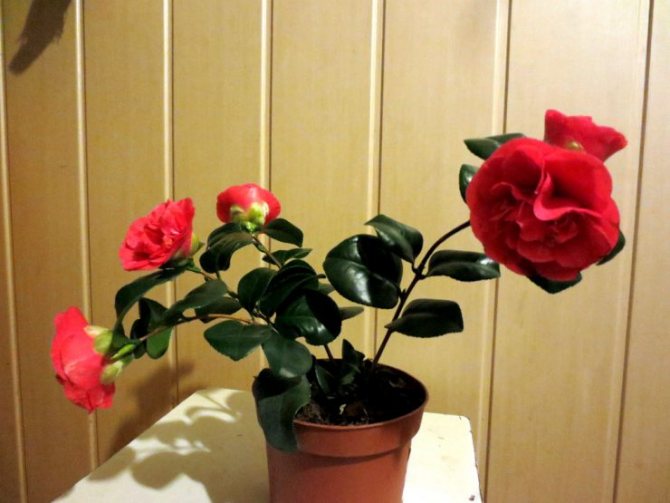

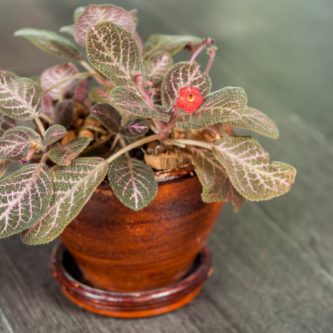

How to grow and care for an episode at home (50 photos)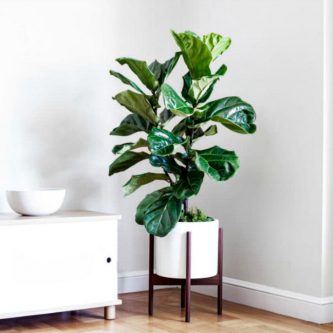

All about ficuses: 30+ varieties with detailed descriptions and photos
- Venus flytrap - benefits in the economy, especially breeding and home care (50 photos)
If you've just started a plant, keep it in a cool, dark place for the first few weeks. And then, transfer to a permanent place where the temperature should exceed 16 degrees.
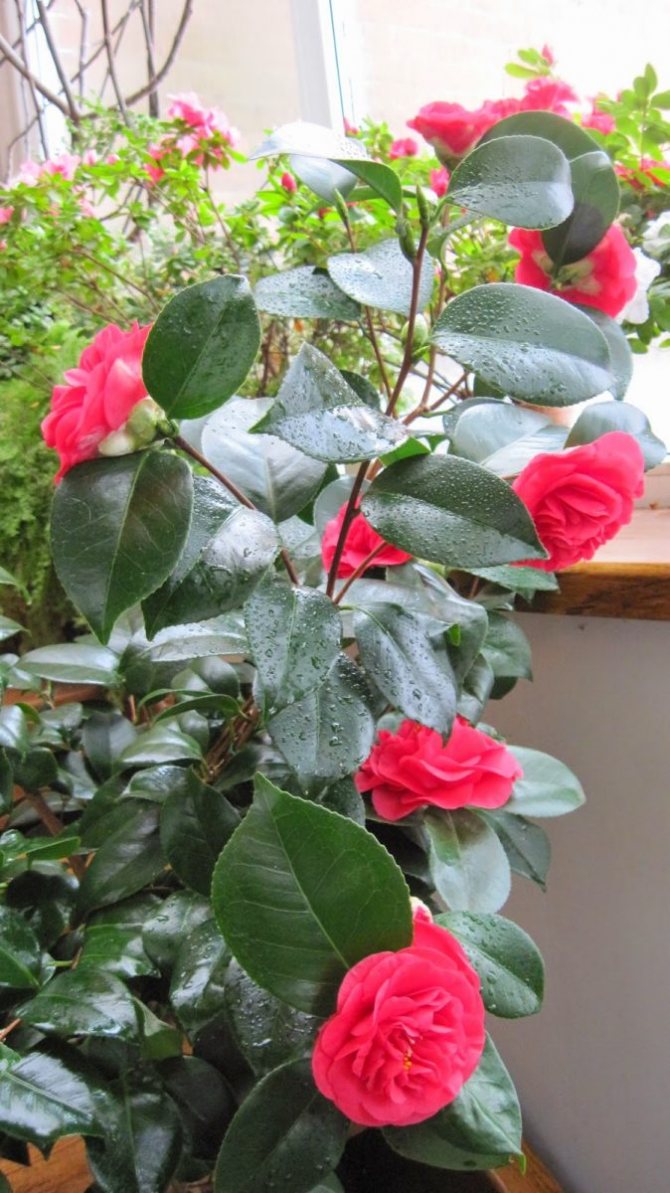

In the summer, take it to the balcony or any place in the fresh air, but remember that camellia is afraid of the bright sun, choose a shady position, or cover it.
Beautiful camellia - an odorless flower for a perfumer, a symbol of Chanel and Japanese samurai
Camellia is not the most popular flower in our climatic zone. Few people know what it looks like, and you can see it live only in botanical gardens and greenhouses. The thing is that the birthplace of camellias is Japan and a little southeast Asia. This oriental beauty is very picky about living conditions, although it is distinguished by enviable frost resistance. Camellia does not like heat, the plant must be protected from direct sunlight. She prefers coolness, diffused lighting and abundant moisture. Camellia will please with flowering only if the temperature is kept no higher than 12 ° C.


Camellia - oriental rose; the winter flower, one of the symbols of this season, usually blooms from autumn to spring. It is curious that the camellia does not rain from the petals, the flower falls entirely.
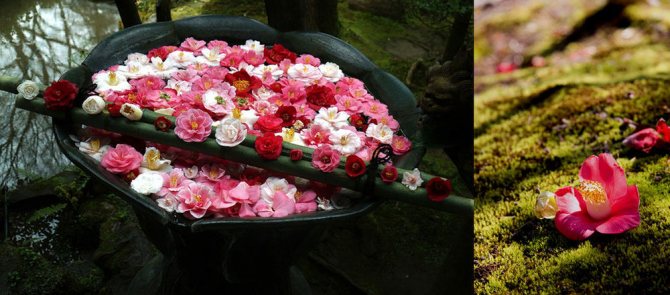

So what is so remarkable about camellia? At first glance, it may seem like an artificial plant. Its leaves and flowers seem to be made of wax - so glossy and dense they look and feel. There are about a thousand different varieties of camellias, the flowers vary in size (4.5 to 15 cm), and the color can be white, red or pink. Sometimes camellias resemble roses, but unlike the queen of flowers, they are completely odorless.


Of course, the birth of a flower is shrouded in legends. One of them tells about Cupid's unrequited love for beautiful ice nymphs from the planet Saturn. Tired of earthly caresses, Cupid went in search of other planets. There he saw a beautiful picture - on the shore of a frozen lake, surrounded by high sparkling ice rocks, several fabulously beautiful nymphs were sitting. They played ice harps and sang, captivating with the beauty of their voices. Cupid fired one arrow at the heart of each girl: but it was all in vain, the arrows bounced off their hearts. No matter how much Cupid shot his love arrows at them, beautiful women remained indifferent to his charms. Cupid had no choice but to return home and complain to Aphrodite about the coldness of the ice beauties. Aphrodite, in order to pacify her son's resentment, commanded the nymphs to go down to earth, turned them into flowers and threw them into the most remote corners, so that they, as it were, wax, devoid of their usual floral tenderness and aroma, bloom alone. Since then, camellia has been a symbol of beautiful, but cold women.
In Europe, the flower first appeared at the beginning of the 18th century. A faithful fan of camellias was Josephine, the wife of Napoleon Bonaparte. One of her portraits shows a bouquet with a white camellia. The flower became especially popular in the 20-30s of the 20th century. The mother of the current reigning queen was very fond of camellias, and they grew in all her gardens.
Portrait of Josephine with a bouquet of camellia.
Camellias, despite the coldness attributed to them, have inspired many to create masterpieces in their honor. The meaning of the flower in the west is honesty and perfection. For example, Dumas-son wrote the novel "The Lady of the Camellias", where the main character appeared in society exclusively with a boutonniere of these flowers. The prototype of the Lady was a real woman, the Parisian courtesan Marie Duplessis, the author's mistress. The novel made an indelible impression on the Italian composer Verdi, and he composed the opera La Traviata based on his plot. The heroine of the opera gives a camellia flower to her lover, so red camellia means a broken heart and great love.


In the old days in Japan, camellia (tsubaki), like sakura, symbolized a short but bright life, in a halo of glory, or loyalty to a master even in the face of death. The tree was revered by samurai, it was always present in their gardens, samurai respected a noble death, but farmers and traders did not like this flower and believed that camellia brings misfortune, because its red flowers fall, reminding people of severed heads.
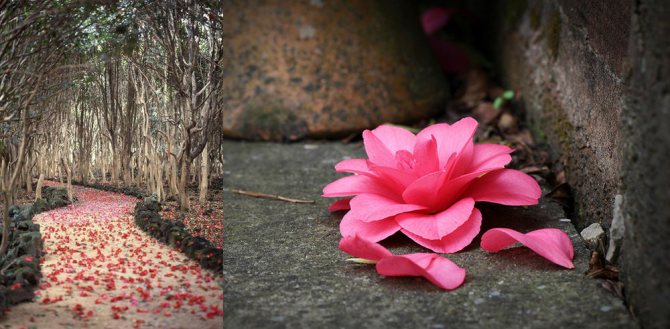

Many Japanese traditions are associated with camellias, for example, white camellias are used for wedding ceremonies as a symbol of longevity. Camellia is often used in spring flower arrangements along with peonies. Buddhists believe that camellia helps to expel evil spirits. Camellias are also used to decorate the tea ceremony. From time immemorial, Japanese poets have composed odes in which they extolled their cold beauty.
Into the old well
Camellia drops flowers -
Bursts in the darkness.
(c) Esa Buson.
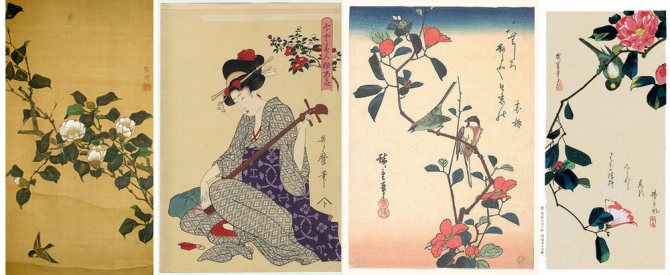

But back to modernity and its symbols. A large flower with rounded petals is one of the most recognizable emblems of the Chanel brand. This flower is camellia. The flower is constantly featured on all accessories, clothes and decorations of the fashion house. But how did the camellia get on the fashion stage?


Coco first fell in love with this flower after reading the novel "The Lady of the Camellias". The main character complemented her image with a magnificent white camellia, thereby showing the world that her heart remained pure and untouched.
In 1908, Chanel met Briton Arthur Edward Capel. He was rich, courteous, and very handsome. Coco fell in love at first sight. They spent nine years together. Arthur was never faithful, in 1918 the couple broke up and he married another. And yet, this is the only novel that Chanel yearned for the rest of her life. Kapel died tragically in 1919 in a car accident. Coco erected a monument by the road, and for many years she visited him, leaving a bouquet of camellias. This was the first flower she received as a gift from him.
For Chanel, the camellia was a symbol that personified the love of her life. The second reason why Coco Chanel fell in love with this flower is that it has no scent. This meant that nothing would mix with her Chanel No. 5 perfume.


Since the 1920s, Chanel has depicted the camellia on all garments. Coco brought back brooches from oblivion and gave them the shape of camellias, causing a huge scandal, and forever entering the history of fashion. Since then, the image of the flower has become a cult wardrobe item and is present on all products produced by the fashion house.


The symbol of the Chanel fashion house is depicted on the embroidery of blouses, dresses and shoes, on handbags, wallets and sunglasses. And even rain boots! This flower can be seen on a small, strict black dress, which has become the standard of style.


In addition to clothing, the camellia flower is an essential addition to all accessories. Chanel eye shadow palettes, blush and powder are pressed into the shape of a camellia.


And even in perfumery, camellia is regarded as a perfume note. How do you ask? After all, this is an odorless flower! Perfumers could not pass by the external beauty of the flower, which fascinates at first sight. Today, in perfumery, camellia is understood as a conditional component consisting of floral notes of peony and tea leaves. The aroma of this composition can be characterized as fresh, green, with a slight astringency.
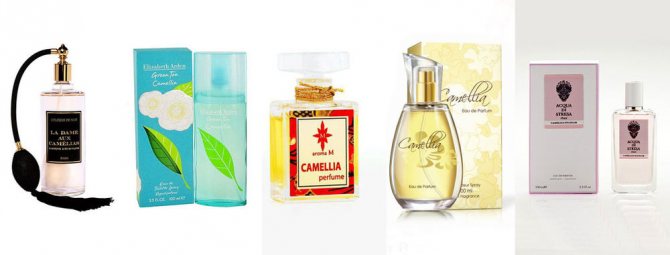

I hope this collection will be useful and inspiring.
Best regards, Sakura Shop.
How to water properly
Use filtered water for irrigation. Water as soon as you find that the topsoil is dry, just don't overdo it. Do not flood the plant, otherwise it will simply rot.
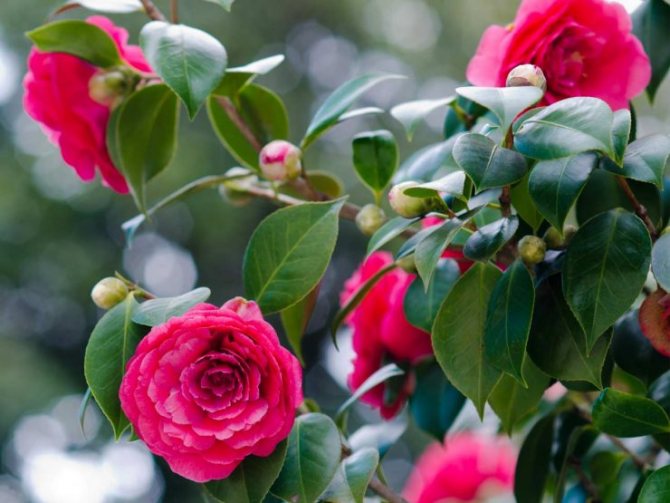

In hot weather, spray the camellia twice a day to increase humidity. Due to insufficient moisture, leaves fall off, and with an excess of moisture, they change color, buds crumble.


The subtleties of growing and care in indoor conditions
Garden camellia in temperate latitudes is cultivated in closed ground, therefore, we will consider the features of planting and caring for a plant in a city apartment or a private house.
The way home
Autumn-beginning of winter is the peak of camellias on sale. If you were presented with a flower, first of all carefully examine it.
- A healthy plant has clean, dark green foliage, buds do not dry out, flowers with dense elastic petals.
- The root collar is flush with the soil.
- The substrate should be moist, but at the same time crumble in your hands.
Even if something is wrong with the plant, do not rush to transplant, let it adapt to a new place, get used to the microclimate of the room.
Conditions of detention
But the right conditions need to be created from the first day.
For Japanese camellia, namely its hybrids are sold more often than others, diffused light is needed. In the cold season, a window sill, a glazed balcony on the north or east side is suitable. With the onset of spring, the plant will be uncomfortable close to the glass, sunburn is possible, so it is better to keep it at some distance from the window.
A common option for summer keeping a flower is in the garden. Pots with a plant are dropped in the lacy partial shade of trees, where there is a lot of diffused light. They are accustomed to the open air gradually, first taking them out for several hours. They return to the room with the onset of low, but positive! temperatures.
The second vital condition is temperature. The main enemy of blooming camellia is city heating; so that she does not get sick, in winter she needs a temperature in the range of 10-12⁰ C. Therefore, feel free to purchase a delightful flower if you have a glazed loggia, a cool veranda or a winter garden.
In summer, the plant feels comfortable at a temperature of 20-25⁰C, with a good supply of fresh air it can withstand hotter days. The temperature should be gradually reduced from about mid-autumn - this has a beneficial effect on the laying of flower buds.
The third condition is high air humidity. The ideal mode (90%) can be created in the greenhouse, in the room this figure is slightly lower. Reach it with a special humidifier. If there is none, spraying is carried out, a vessel with water is placed next to the pot so that evaporation occurs.
Watering
Camellia is picky about watering - this is the element of care, the intricacies of which you need to know both in indoor conditions and when growing crops in the garden. Here are the basic rules.
- For irrigation, it is recommended to use warm and soft water (rain, thawed, purified).
- Always watered in moderation, avoiding excessive drying out and waterlogging of the coma. Marker - the wet substrate crumbles.
- The plant requires more frequent watering during the growing season (spring-summer), less watering during the dormant (flowering) period - late autumn, winter.
- After watering, the excess water is removed from the pan.
Top dressing
Flowering depletes the plant. With its end, top dressing begins. It is best to use professional fertilizers for camellias, azaleas, rhododendrons, in which the complex of nutritional components is already balanced for the needs. The frequency of top dressing is once every two weeks, all the time while the shoots are growing. Since August, feeding is stopped - this is a signal for laying generative buds and forcing buds
Transfer, choice of soil mixture
Camellia flower is usually transplanted every 2-3 years. The approach to choosing a planting container is the same as for other indoor plants - 1 cm larger in diameter than the previous one. Plastic pots hold moisture well.
It is better to purchase a soil mixture intended for camellias, azaleas. Its main property is an acidic reaction. Structure:
- horse (sour) peat;
- rotted coniferous litter;
- leafy land;
- perlite;
- coarse river sand.
Before transplanting, the flower is freed from the old substrate, the roots are slightly "combed", removing the rotten parts. A shard is placed on the drainage hole, drainage (expanded clay, stones) is poured, sprinkled with a layer of coarse sand, and then the planting proceeds directly. The substrate is pre-moistened, watered after planting so that it better envelops the roots.
The most suitable time for transplanting is the end of flowering.
Do you need pruning?
If you are not forming a bonsai, the plant needs minimal pruning. What and when are they pruned?
- Shoots that spoil the appearance of the crown.
- Twigs growing inward and disturbing others.
- The top of the shoot, if it is necessary to stimulate its branching.
It is advisable to prune before the start of vegetative growth, i.e. in the spring. You cannot combine transplanting and pruning a flower, this will complicate its restoration.
The soil
Camellia prefers acidic soil. A special azalea blend is available at the store. Which will really please the fastidious plant.
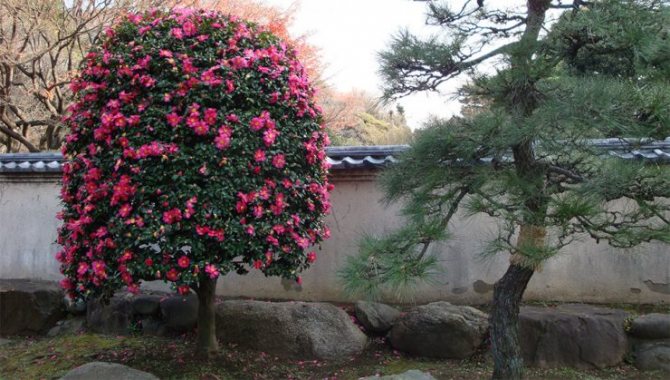

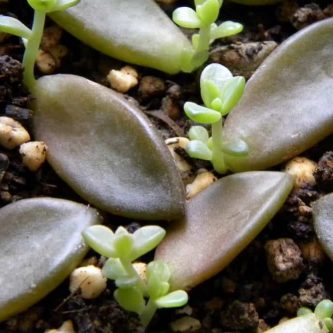

How to properly care for a money tree: transplantation, reproduction, circumcision, disease. 30+ photos, signs

Echeveria - how to care for indoor succulent plants? Watering and soil selection features (55 photos + video)
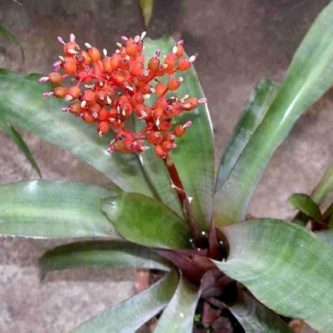

Ehmeya: indoor ornamental flowering plant. Nursing feeding and reproduction (54 photos)
Reproduction
Camellia is propagated by cuttings and sowing seeds.
Cuttings of semi-lignified young shoots in July:
- With a sharp pruner, cut off the shoot with 4 leaves. An oblique cut is made under the lower knot, sprinkled with Kornevin powder. The leaf blades are cut in half to reduce evaporation.
- Fill the container with a 1: 1 mixture of sand and peat.
- At a slight angle, insert the cutting into the mixture.
- Water, cover with a plastic cap and put in a warm place. Rooting temperature +25 degrees.
The roots may not appear earlier than in 2–4 months.
This method guarantees the preservation of the plant's variety.
Sowing seeds:
- Cut the hard shell and soak the planting material for a day;
- Sow into cups filled with a mixture of peat and sand to a depth of 1 cm;
- Drizzle, cover with glass, put in a warm place.
Only fresh seeds have good germination. Sowing is done immediately after the seed pod has ripened.
Pruning
To avoid small camellia flowers, and to achieve a thicker growth, you need to cut off the extra buds. Leave no more than two per branch.


Camellia loves to grow, in order to avoid awkward branches growing in different directions, the plant must be pruned. This will add the accuracy and beauty of the camellia, besides, it will get rid of the weak and sore parts.
Where can you buy camellia?
Specialized enterprises start selling a spectacular flower in winter, at a time of mass budding. Sales are conducted through retail and online stores.
Prices at the beginning of the 2019 winter season ranged from 1 to 7 thousand rubles. The end of sales was marked by the announcement of discounts of up to 40% of the original cost.
The purchased flower must be carefully removed from the pot and its roots must be examined. If they are ok, then no transplant is required. It is enough to locate the plant in a permanent, cool place and water it regularly. Spraying the leaves with Epin's solution will help to adapt to the new conditions of camellia.
Camellia photo
What problems do gardeners face
How to take care of the camellia depends on its flowering. Errors in care are the main cause of disease and death of the plant.
- If foliage falls, then you are making mistakes with watering.
- Dead leaves - the plant lacks nutrients.
- If, as in the photo, brownish spots have formed on the leaves, then remove the pot from the windowsill as soon as possible. These are signs of sunburn.


- Poor flowering is a sign of soil acidification.
- In the event of an attack by a scale insect, tick or aphid, you need to treat the foliage with special preparations, or an ordinary soap solution.
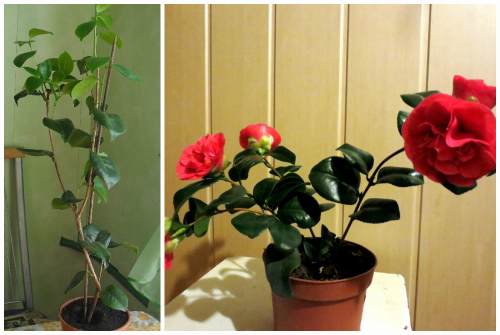

The video below clearly shows how to grow a camellia and make it the queen of the winter garden. Have you had any experience in breeding camellias? Write about the most important, in your opinion, in this process to the readers.
Diseases and pests
When growing camellia, flower growers often face some problems. The most important of them are diseases and pests.
Yellow spot... The leaf plate is covered with yellow spots of irregular shape. At the initial stage of the disease, damaged leaves are removed, and the plant is quarantined.
Phylostictyosis. Brown spots of various shapes appear on the leaves. This disease can appear with high humidity. For the plant to recover, it is necessary to regulate the humidity, remove all affected leaves, and before the onset of cold weather, the plant is treated with copper sulfate.
Weevil-skosar. This insect can be recognized by its leaves. The edges of the leaf plate are nibbled, and the plate itself loses color over time, dries up and falls off. The insect lays the larvae in the ground. The most dangerous are adults, as they very quickly damage the root system, which leads to the death of the plant. Treatment consists in processing the flower with a solution of "Mukhoed" or "Medvedka".
Shield. Damages young shoots, forming golden brown tubercles on them. You can fight the pest by wiping the foliage with kerosene.
Mite. The insect appears when growing a shrub in a room with high temperatures and low air humidity. When affected by these insects, the leaf plate becomes covered with yellow spots, which quickly grow without treatment. You can get rid of a tick using insecticides.
How to get rid of midges in indoor flowers using simple methods. In a special publication of our portal, we will tell you in detail how to get rid of pests in indoor flowers. You will learn the reasons for their appearance, the types of midges and their signs and measures to prevent the appearance of midges.
Camellia pests
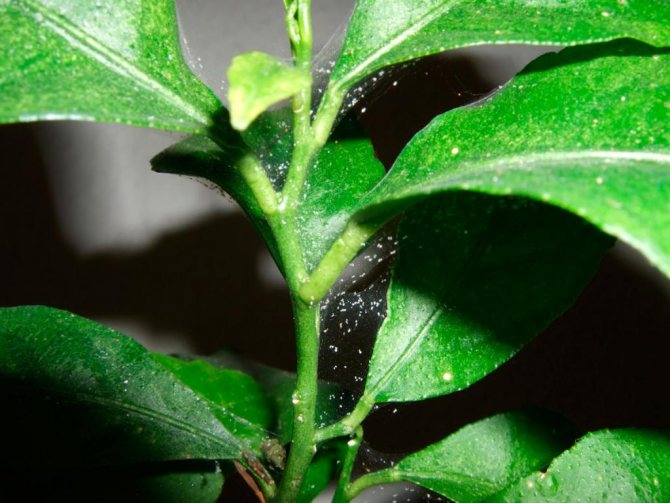

Most often, the plant becomes a victim of a spider mite, aphid or mealybug.
The spider mite is a common pest of indoor plants. Its appearance can be guessed by the dark dots on the leaves. And the stems of the plant are usually shrouded in a thin cobweb. If the camellia is hit by a spider mite, then it is best to treat the leaves with an oil emulsion or soapy water.
A soap solution or insecticide can also be used against aphids.
The mealybug lays white larvae on the leaves of indoor camellias. In this case, the larvae are removed from the leaves (the leaves can be trimmed if necessary). The crown of the plant is treated with insecticides.
Description of the plant
Garden camellia (cameo) is an evergreen flowering shrub that came to Europe from Japan, China and Korea, where it grows right on the edges of rivers and forests. It gained popularity among landscape designers thanks to glossy dark green leaves with pointed ends and large flowers of pale pink, white-lilac color. Under natural conditions, bush camellia blooms in winter when temperatures reach 12 ° C. Moreover, the buds cover the branches for 2-3 months, sometimes longer.
With proper care, a shrub or tree grows up to 3-10 m, releasing flowers with a diameter of 5-13 cm. Each opened bud has 5 petals and many stamens, does not fall off the branch for a month.
On a note. Camellia is usually grown in the garden only by residents of warm regions, since the tree is quite thermophilic, even hybrid frost-resistant varieties cannot withstand frosts below 20 ° C. However, if you wish, you can bring the bushes planted in tubs or flowerpots into greenhouses, sheds in the fall, and carefully cover them for the winter.
In landscape design, evergreen bushes are used for landscaping, creating unusual garden or park compositions. They sit them both singly and in groups. Garden Japanese camellia is especially appreciated by designers, growing up to 10 m, producing single buds on the tops and in the axils of branches. The flowering of this interesting variety is shown in the photo below.
1. Seven Secrets of Success:
| 1. Growing temperature: even during the period of active growth, camellia should be kept in cool conditions - at a temperature of 7 to 15 ° C. In the fall, the temperature of the content is further reduced and the plant should spend the winter months in a cold room with a temperature of 5 - 7 ° C. |
| 2. Lighting: shading is possible on the hottest days, the rest of the time the direct rays of the sun can fall on the plants.Well lit location with plenty of reflected sunlight. |
| 3. Watering and humidity: dry the soil between waterings by 1 - 2 centimeters in depth, significantly reduce watering in the autumn-winter period. Air humidity is high. |
| 4. Pruning: formative pruning is carried out after flowering, sanitary pruning - as needed, with a sharp and sterile pruning shears or a garden knife. |
| 5. Priming: must have an acidic pH and good drainage, as well as a loose structure that allows not only water but also air to pass to the plant roots. |
| 6. Top dressing: liquid mineral fertilizers for azaleas and rhododendrons every 2 weeks in spring and summer. Camellia is not fed in autumn and winter. |
| 7. Reproduction: Camellia propagates by seeds or apical cuttings, grafts. |
Botanical name: Camellia.
Camellia flower - family... Tea rooms.
Homeland of the plant where camellia grows... Japan, China, Korea.
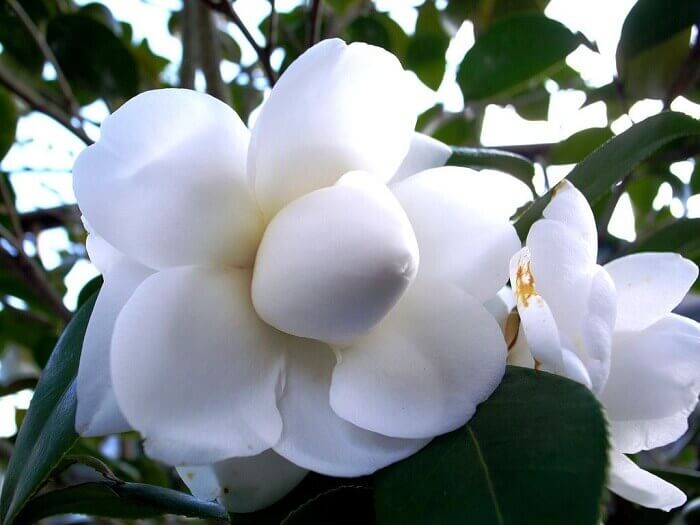

Description... Camellia - what is this flower? The genus contains magnificent shrubs with numerous branched stems bearing shiny, dark green, leathery leaves up to 10 cm long. The leaf blades have slightly serrated edges.
Buds appear on the tops of young one-year-old shoots and in the axils of the upper leaves. Flowers large, rose-like in shades of white, pink, crimson, yellow, simple, semi-double and double, single or in small inflorescences, each up to 15 cm in diameter.
Bred varieties with two-color petals, which have stripes and strokes. Each flower remains open for a week.
It is interesting that the period of active growth occurs after flowering - large buds located on the tops of the shoots near the buds start to grow.
Height... Most species reach 3 - 4 m... in height, however, when grown in room culture, their sizes become more modest, and, in addition, they are regulated by pruning. Domestic camellias develop slowly.
↑ Up,
Flower transplant
Camellias, unlike many houseplants, can be transplanted during the flowering period. This is explained by the fact that her flowering is a dormant period, and the rest of the time she grows and forms quite actively.
For a young camellia, a transplant is required once a year. In the future, you can transplant the plant every few years.
As needed, the camellia can be transplanted if the pot has become too small, or if the root system is diseased. In the second case, when transplanting a plant, it is necessary to carefully remove rotten roots. The procedure for transplanting camellias is as follows:
- A new pot is being prepared. It should be larger in volume than the previous one; there should be a hole at the bottom.
- Drainage is poured into the bottom of the pot.
- Special soil is prepared.
- Drainage in a pot is sprinkled with soil (in a small amount).
- The camellia is carefully removed from the pot. In this case, it is important not to damage the root system.
- The plant is lowered into a new pot, soil is added. Important: the neck of the plant should not be completely covered with earth.
- The flower is watered abundantly with soft water at room temperature. The water from the sump must be drained.
Beneficial features
Camellia brings not only aesthetic pleasure during the period of mass flowering, but also has other useful qualities:
- Gives positive energy, contributes to the normalization of relations between family members and harmony in intimate relationships.
- The essential oil from the leaves is used in cosmetology and medicine.
- The decoction of the leaves makes the hair shiny and silky when rinsed.
- After a special treatment, the young leaves are used for the production of tea.
Growing problems and their elimination
Common problems when growing room Camellia and how to solve them:
| Problem | The reasons | Decision |
| Brown spots on the leaves | Sunburn | Move the flowerpot to partial shade |
| Poor bloom | Soil acidification, fertilization with calcium and magnesium | Water the plant only with soft water, do not overflow the bush, select suitable fertilizers for feeding |
| Yellowing and falling leaves | Lack or excess of moisture, deficiency of nutrients | Fertilize camellia regularly, normalize the irrigation regime |


Choice of place and conditions of detention
Planting a camellia and caring for it in the garden may seem quite difficult to some, because a perennial flower requires proper wintering, does not tolerate severe frosts, and the proximity of groundwater. In what conditions should a beautiful cameo be grown?
- Lighting and location. The plant loves diffused sunlight, but the bright rays of the sun are unpleasant for it, can cause burns to leaves and buds. The best option for planting is the western or eastern part of the garden, where there is no wind and strong shade. It is better to plant seedlings on a mound, along fences or walls of the house.
- Temperature. Modern frost-resistant varieties are able to withstand frosts of 15-20 ° C in winter. However, in central Russia, bushes need shelter with non-woven material and spruce branches, otherwise the branches with roots will die during prolonged cold weather. Plants in pots are able to overwinter at temperatures of minus 10-15 ° C.
- Air and humidity. Bushes do not tolerate strong gusts of wind and drafts, so it is worth considering protection from them throughout the year. In spring and summer, it is also necessary to protect crops from drought and overflow.
- Priming. Cameo prefers to grow in acidic soil. If a purchased soil mixture is used for growing in a tub, a composition for rhododendrons or azaleas is suitable. If the soil is prepared independently, peat, sand, coniferous litter, humus and perlite are mixed in equal proportions. It is imperative that a drainage layer of expanded clay, fine gravel or pebbles is poured onto the bottom of the planting pit.
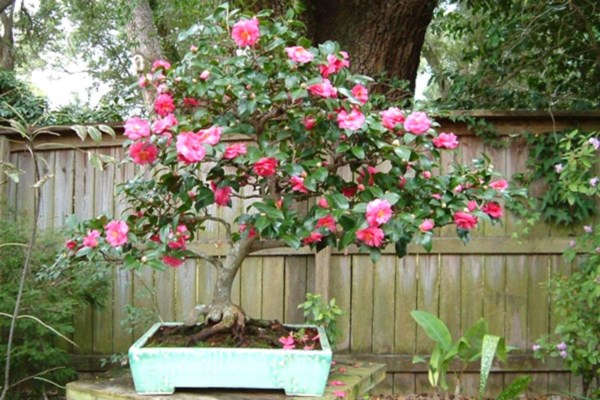

Madame Coco and camellias
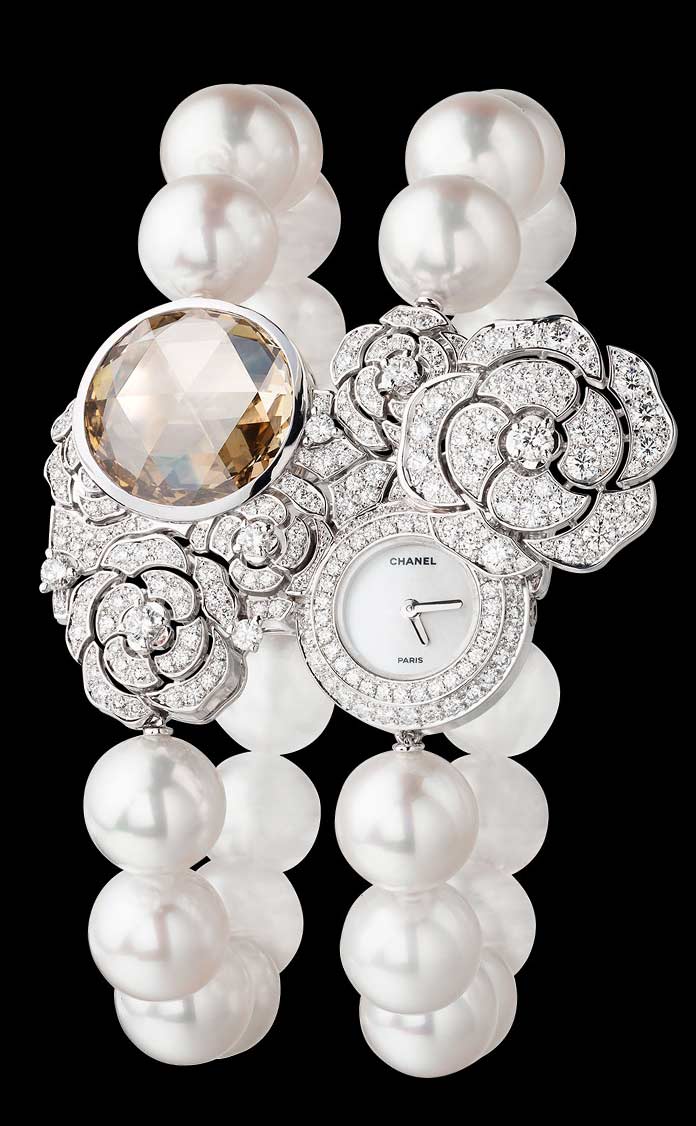

The flower, combining tenderness and severity, has become a symbol of the Coco Chanel brand. This strong woman gave the camellia the symbolism of exquisite mystery. Simple and charming with its splendor, the flower won Coco's heart after reading the novel by Dumas. But there is another version of her special love for camellias.
Coco first received a flower as a gift from her lover - Arthur Capel. Subsequently, she constantly brought a bouquet of camellias to the place of his tragic death. For Madame Coco, this flower became the personification of her love. A special sympathy for him in her eyes was given by the absence of a smell that could interrupt her favorite perfume.
Whatever the interpretation of a beautiful flower, it still leaves few people indifferent. The attractive appearance and colorful bright flowering overshadowed the main drawback - increased moodiness during cultivation, making the camellia the favorite of many flower growers. Since the time of Dumas, the "Japanese rose" has remained that mysterious and attractive flower, in which everyone finds their own special meaning and symbolism.
Mistakes of novice florists
- Camellia sheds foliage - very dry soil. Watering time is determined by the condition of the soil, if the soil has dried out by 5 cm, then the plant needs moisture.
- The leaf plate acquires a brown color, and the unopened buds fall off - the overflow of the bush. In this case, the plant is transplanted into a new substrate.
- The leaves turn brown - a sunburn. The flower grows best on the east or west side.
Capricious plant - camellia
Camellia is an ornamental plant with a long flowering period. It will perfectly complement both the home interior and will be irreplaceable in the landscape decor. In order for the shrub to please with its flowering, it is necessary to surround it with care and love.
Types of camellia home with photos and names
Three types of camellia are most commonly found:
- Mountain or Miyagi;
- Chinese or tea bush;
- Japanese.
They differ in a variety of colors, the shape of flowers and petals, their number and texture, as well as the number of buds. The most popular varieties of Japanese camellia that are available to grow have the following characteristics.
Camellia Double White
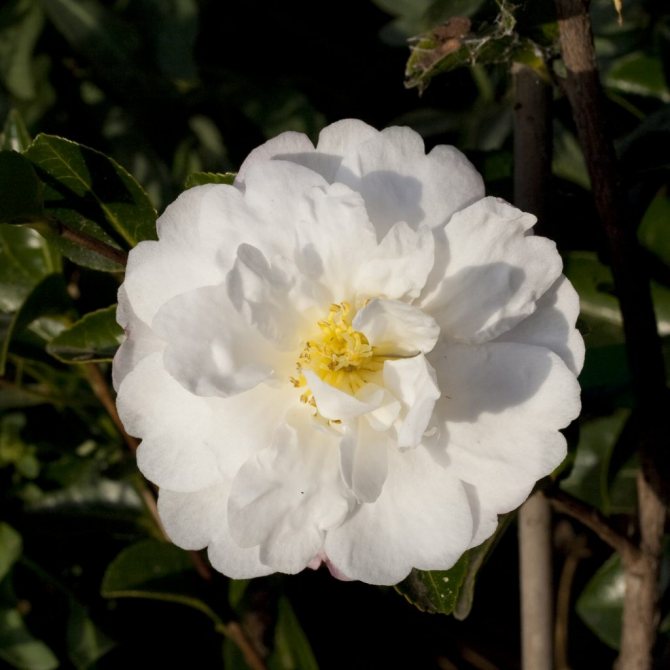

Snow-white, spherical, double flowers have perfect symmetry. Smooth petals are slightly wavy at the outer edge. The leaves are elongated, glossy.
Camellia Giulio Nucci
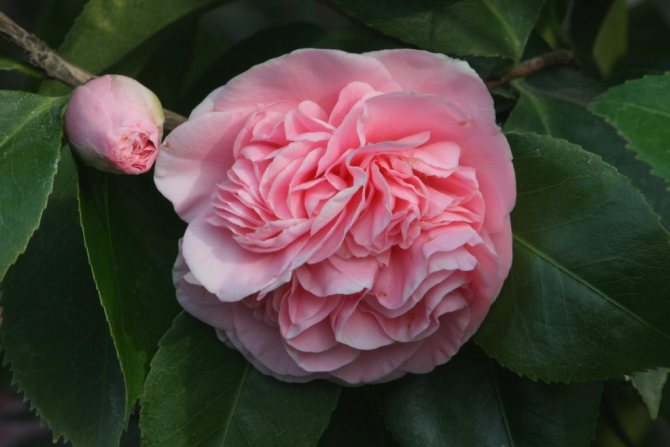

It has several types of crimson petals: rounded or elongated outer, small, sometimes twisted into curls inside the flower. Numerous stamens are yellow or white with yellow anthers.
Camellia Margaret Davis


The variety is two-color, semi-double. The flower consists of two types of petals: rounded at the edge and narrow, white - inside. They are located tightly to each other. Rounded white petals have a pink or red border around the edge. Some varieties have crimson specks.
The origin and appearance of the plant
This aristocratic flower came to Russia from Japan and China. In these countries, camellia is used not only to decorate land. The petals of her flowers are added to the tea, giving it an exquisite aroma and taste.


Japanese garden camellia flowers
Camellia is a perennial shrub or tree related to ornamental evergreens. It belongs to the Tea family. There are more than 200 varieties of this shrub in the world.
The 3 main varieties that are grown in central and northern Russia include:
- Oilseed;
- Mountain;
- Japanese.
The oil camellia reaches a height of 10 m. Basically, this species is not common on the territory of Russia. More often it can be found in forests near water bodies.
Mountain camellia grows no more than 5 m in height. Most often it is a bush growing on mountain plateaus. Differs in flowers of a simple form.
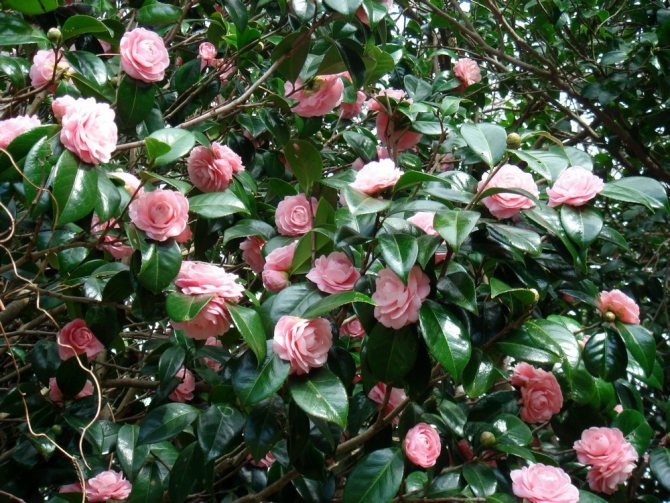

Oil camellia
The Japanese bush camellia reaches a height of about 2 m. It was from this species that many hybrids were bred. One of the popular hybrids is Williams' camellia. It is adapted to low air temperatures. Its distinctive feature is the dropping of wilted buds from the branches. No other species will shed color on their own.
Plant flower description
Flowers of different varieties have different diameters. You can grow on your site a camellia with flowers, the diameter of which is 1 cm, or a camellia, the diameter of the flowers of which can reach 12 cm. In most cases, the size of the flower depends on the variety.
Even when purchasing seedlings of varieties that are distinguished by large flowers, you may not see those on the branches of the plant. This can be caused by improper plant care, as well as an unsuitable planting site.
Interesting! Camellia shrub is distinguished by a variety of colors. In nature, you can find white camellia, red, pink, orange, variegated, etc.
Flowers are located on the branches of the plant singly. There is no aroma. The petals are dense, with oval edges, double, semi-double and simple.
Winter hardiness of garden camellias
Winter-hardy camellia varieties were bred relatively recently. The plant got to Europe in 1738, in Russia it became possible to grow it closer to the middle of the twentieth century.
Symbols and interesting facts
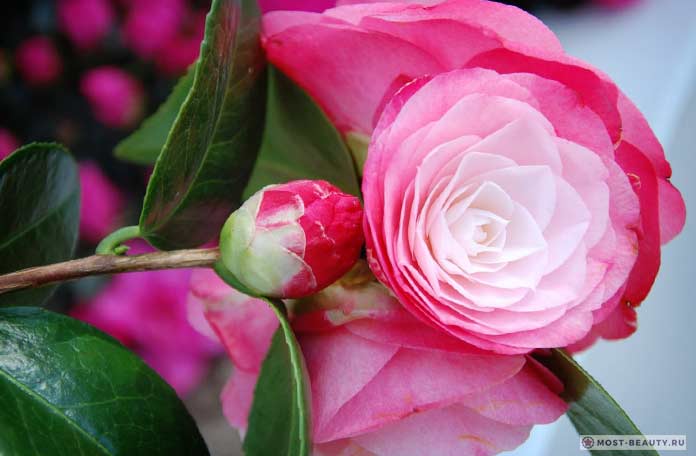

In China, this beautiful plant symbolizes beauty and is the personification of fortitude, because flowering occurs in autumn and winter. According to feng shui, a flower attracts good luck. In ikebana, it is combined with a pine branch. Such a composition identifies longevity, while the flower means tenderness. Red camellia symbolizes in China a sincere feeling of love, yellow - fiery passion, white - dreams and the anticipation of a dream come true.
For the Japanese, camellia symbolized the short life of a warrior, lived in the glory of his victories. It was not for nothing that it was originally considered the flower of the samurai. There was also a belief that the warrior who touched her would soon say goodbye to life. It arose from the fact that the camellia, when it fades, does not crumble in a rain of petals, but falls to the ground in a whole inflorescence, like a head from the shoulders.


As a samurai flower, camellia is considered a good choice for a man's tattoo.Her image will testify to the endurance and good taste of the owner of the tattoo and will attract good luck to him. The Japanese have an image of white camellias on a tattoo - a symbol of long life.
By the way, there is a very interesting article about the most beautiful tattoos on our website. If you are thinking of getting yourself a tattoo, follow the link and you will find something suitable for yourself.
At all times, this flower had a dual meaning. On the one hand, it is a symbol of nobility and spiritual purity, on the other, it is the personification of sadness and cold indifference. It is curious that the white camellia in America was used as a symbol of the fair-skinned race among the adherents of the Ku Klux Klan.
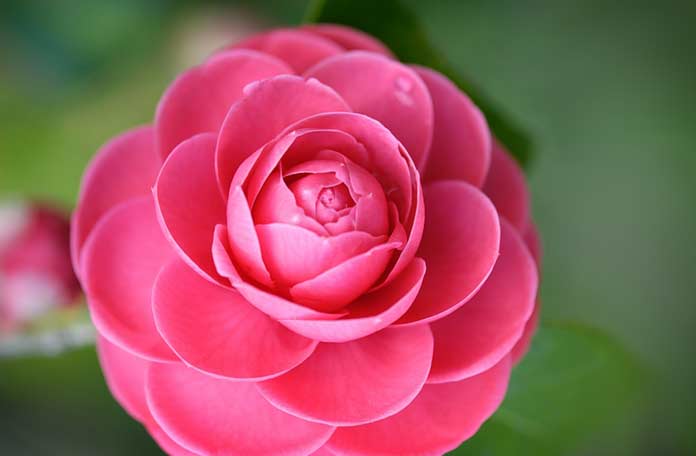

The beautiful tsubaki is considered a symbol of cold beauty. It is sometimes called "stone flower", which is preferred by women who are able to love only by calculation. Therefore, these flowers are rarely given, and even more so it is not customary to use them in wedding bouquets. But jewelry with camellias, which are found in many collections, is considered a valuable gift.
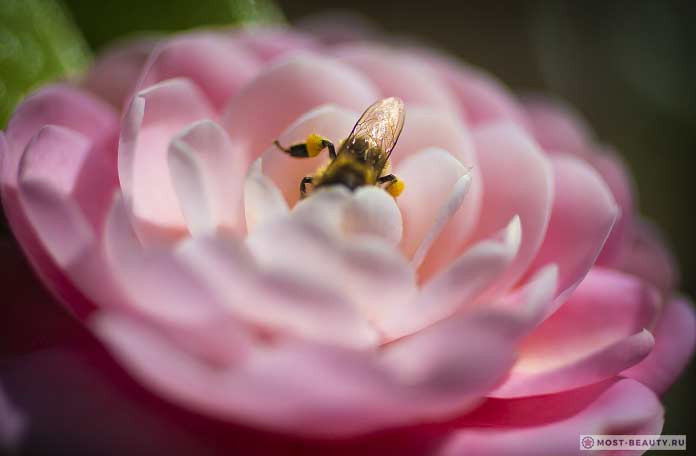

Camellia standard: planting and care
Stamp camellia street assumes shelter for the winter period of time, therefore, when planting, you need to plan a free space next to the plant, because it will bend to the ground. The optimal planting time is mid-spring. If the flower was purchased in a pot, it can be planted even in summer.
The width and depth of the planting pit depend on the volume of the root system. The roots in it should be free, not breaking. Drainage must be laid on the bottom.
Important! For the first time, the seedling is tied to a support so that the wind does not break it.
Stamp camellia is not too demanding to care for. In the spring, prevention against diseases is carried out, closer to winter, when the plant throws off its color, it must be pruned. There is one more nuance that should be observed when planting a standard camellia, is that the root neck looks in the opposite direction from the future inclination of the flower.
What is camellia - a brief botanical reference
The evergreen flowering camellia belongs to the Tea family. The plant is native to the tropics of the East and the subtropics of Southeast Asia. In nature, the flower is a shrub or small tree with a loose crown that grows up to several meters. It was named after Camellus, who first discovered this plant and brought it to Europe from the Philippines.
Dark green leaves are rounded, they are located singly or in pairs. The flowers are large and, depending on the variety, are colored red, pink, snow-white or variegated. Flowering occurs in winter and lasts until mid-spring.


Camellia can bloom even during the winter season.
3. Varieties:
3.1. Japanese camellia - Camellia japonica
The most common subspecies of camellia. In its natural habitat, the plant can reach a height of 1.5 to 5 - 11 m. Leaves are glossy, green, lanceolate, leaf blades are hard, young leaves have a burgundy - copper hue. The flowers are pink, white or red, often double, the diameter of the flowers varies from 5 to 12 cm. The flowering period begins in the spring and lasts 3 to 4 weeks.
Unfortunately, this capricious beauty is almost impossible to grow at home - she cannot stand stuffy and warm rooms.
↑ Up,
3.2. Middlebury pink camellia
a very delicate plant with large, double flowers of a delicate pink hue, the main distinguishing feature of which is that the petals, gradually decreasing in size towards the center of the flower, are arranged one after another in even rows.
↑ Up,
3.3. Chinese Camellia - Camellia sinensis
Large flowering shrubs, from the upper leaves of which we all get familiar tea. In nature, plants are capable of reaching a height of 10 m. Leaves are green, lanceolate, glossy, hard. The flowers are creamy yellow, medium-sized - they reach 3 - 4 cm in diameter, with 7 - 8 rounded petals and large orange stamens.
↑ Up,
Another subspecies of Chinese camellia is camellia oleifera - Camellia oleifera - a plant with simple white or pale pink flowers, from the fruits of which tea oil is obtained, which is used in cooking.
↑ Up,
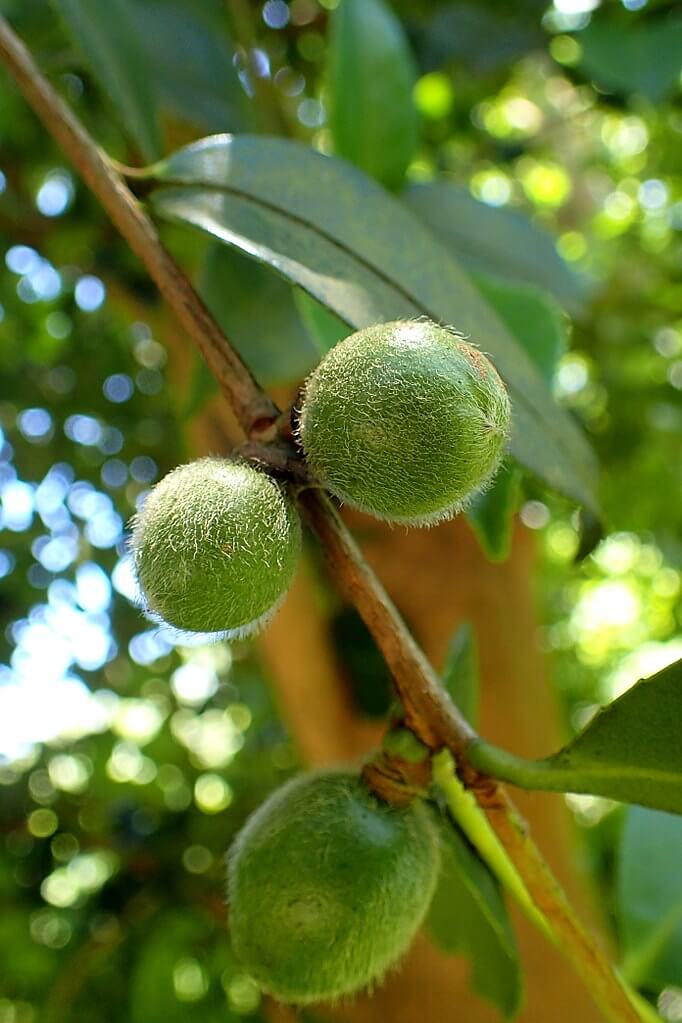

Types and varieties
Gerbera flower garden planting and outdoor care
Frost-resistant varieties of camellia include:
- Donation. Flowers of this variety have a deep pink color and reach 10 cm in diameter. At first glance, the plant is fragile enough, but it is not. This variety is not so demanding to care for. A gardener who has never dealt with camellias will be able to grow it on his site. A feature of this shrub is its very slow growth.
- Freedom Bell blooms with vibrant reds. Dense, glossy petals create a waxy effect. The variety is not afraid of pruning. Any spoiled branches of the plant, and the shrub grows quite densely, can be removed without fear.
Japanese camellia, variety Donation - Debbie. The flowers are purple in color, about 7-8 cm in diameter. The variety is similar to Donation and is suitable for growing by gardeners without experience. Suitable for growing in the Krasnodar Territory, the Urals and Siberia.
- Hagoromo is a variety whose flower color changes. It is also called the Empress. The buds of the plant are light pink, the blossoming flowers are pearl white. The shrub develops slowly, growing in height, not width. The diameter of the flowers is about 10 cm.
- General Colletti. The diameter of the double flowers of this variety is about 7 cm. The petals are white, with coral veins. This variety is popular in the Moscow region.
Watering camellia
The described plant comes from fairly humid regions. Therefore, the flower of the room camellia requires frequent moderate watering, especially in the warm season. When the plant begins to bloom, the frequency of watering can be slightly reduced. It will be enough to water it when the soil in the pot dries up. It is important to ensure that watering is carried out with soft, settled water. Waterlogging the ground is also not recommended. Sometimes you can add a few drops of vinegar to the water for irrigation - this will provide the necessary acidity of the soil.
Rules for care and cultivation in the garden
Outdoor care for cameos when grown outdoors consists of regular watering, top dressing, pruning and a rejuvenating transplant as it grows.
- Watering. In the summer, the cameo is watered abundantly; in the heat, the leaves are additionally sprayed so that they do not dry out. In the fall, watering is reduced so that the roots do not get wet during the rainy season.
- Top dressing. In spring and during summer growth, camellia is fed 2 times a month with mineral fertilizers or organic matter. The compositions are applied in liquid form immediately after watering. In the fall, fertilization is stopped.
- Loosening, mulching. Loose the soil a couple of times over the summer, usually after watering. Mulch for protection from weeds and drying out of the soil with spruce litter, peat, dry leaves or sawdust.
- Pruning. Formative pruning of the shrub is carried out in early spring in order to end up with a bush with an even and dense crown. Protective pruning is carried out in the fall, it helps to protect the branches from freezing in the absence of snow or shelter.
- Transfer. Young plants are transplanted annually, then, after the beginning of flowering, every 2 years. The transplant is carried out during the rest period, from October to November.
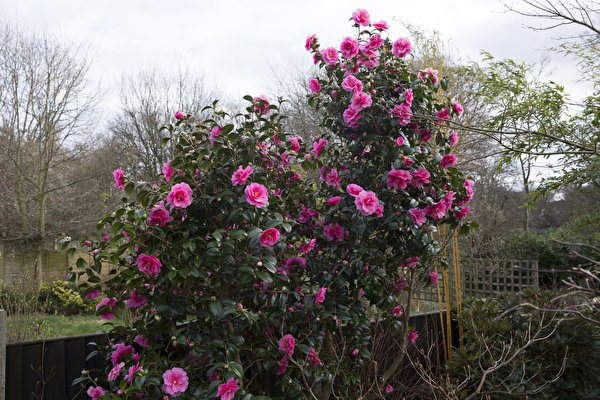

What does the indoor and garden color of camellia look like in the photo?
Camellia flowers are large, single, simple or double. Their color can be varied: snow-white, scarlet, pale pink or motley. The petals may have streaks, spots or specks that smoothly transition from one color to another. In shape, they resemble a rose, peonies, anemones or carnations.


It is impossible not to notice this flower in the interior.
Catalog of indoor flowers with photos and their names. In a special publication of our portal, we will tell you in detail about indoor flowers. You will learn about the types of indoor flowers, fruit indoor flowers and see the photo gallery.
Garden plant option
Determine the name of the garden flower from the photo. In a special publication of our portal, we will tell you in detail about garden flowers. You will learn about the types of garden flowers, perennials, wintering in the open field and look at the photo gallery.
How camellia reproduces
Camellia can be propagated in two ways: cuttings and seeds.
Reproduction of camellia by cuttings: step by step instructions with a photo
| Photo | Act |
| Camellia is best propagated by lignified cuttings, which are cut in the middle of summer. The stalk must be at least 8 cm long and have 5 sheets. Before rooting the planting material, it must be treated with a rooting stimulator. |
| The seedling is placed in prepared soil, consisting of moist sand and peat in a 1: 1 ratio. Before burying it in the soil, it must undergo phytohormone treatment. This is necessary for better heating of the soil. | |
| For fast rooting, the air temperature must be over + 25 ° C. To maintain a favorable microclimate, a plastic bag or glass dome is placed on the seedling pot. Under these conditions, the cutting will germinate in 60 days. |
Sowing seeds
Seed propagation is simple, effective, but long-lasting. The seeds are sown in a moist substrate consisting of sand and peat, the container is covered with polyethylene and placed in a warm, bright place for germination. The duration of this process depends on the conditions, and it can last from several months to a year.
As soon as the first shoots appear, the film is removed, the seedlings are watered and dived. Each plant is planted in separate pots with a volume of at least 7 cm. Camellia grown from seeds is more adapted to sudden changes in temperature and grows much faster.
IMPORTANT! (click to find out)
IMPORTANT! A plant that has grown from seed begins to bloom at 5 years of age.


The ripe seed pod is dark brown in color.
Transplant after purchase in open ground
The density of its flowering in the future depends on how accurately all the conditions for planting camellia garden were met.
What is needed for landing
To plant a plant in open ground, you should decide on a plant variety and purchase a seedling. The optimal acquisition time is from early May to mid-July. Saplings must be over 4 years old. The roots should look strong, the shoots should be stiff. If the seedling is younger than this age, it can grow in a tub, but outdoors. For the period of frost, it is brought onto a covered veranda or balcony.
Optimal location
An ideal place for camellia is an area with diffused light. Moreover, the scattered rays of the sun should be throughout the day. It is advisable to avoid direct sunlight on the leaves of the plant.


Planting camellia
When choosing a location, areas with through winds should be excluded. It is recommended to plant the shrub on a small hill. This will prevent water from stagnating in the root system.
Step-by-step planting process
- Dig a landing hole. Its diameter should be 2 times larger than the root system.
- At the bottom, a drainage layer is laid out, consisting of medium-sized pebbles. The layer thickness should be approximately 15 cm.
- A layer of prepared substrate is laid out on the drainage layer.
- If the camellia was purchased in pots, then the seedling is removed in such a way that a lump of earth remains on the root system. This clod is placed in the planting hole on the substrate layer and sprinkled on top with prepared soil. If the roots of the seedling are bare, then they are carefully laid out on a layer of soil and sprinkled with soil. It is recommended to press down on top of it to avoid air accumulation between the roots.
- The plant should be watered abundantly.
Introduction
Camellia owes its name to the naturalist Joseph Kamelius, who first introduced the Europeans to this culture. At home, camellia can reach gigantic proportions. Trees 5-6 m high are considered the norm in Japan.In addition, in the city of Hagi, where camellia festivals are held annually, there is a whole grove of Japanese camellia trees, about 15 m high.


Japanese camellia in natural habitat
However, it seems unlikely to obtain such sizes under our growing conditions; Usually, trees or bushes growing in our country reach no more than 1.5 m in height.


Camellia grove
Camellia is an evergreen plant with a dense deciduous mass. Traditionally, a dark green shade of leaves, often glossy, prevails. The size of the leaves is predominantly 6-8 cm; most often, the leaves are oval in shape, but there are also elongated leaves up to 11 cm in length.
The plant branches profusely and usually the outermost of the branches act as peduncles. The buds form in the leaf axils.
back to menu ↑
Read also: Bulbous Flowers Catalog: Description 21 Varieties, for growing in the open field and at home (65 Photos & Videos) + Reviews

